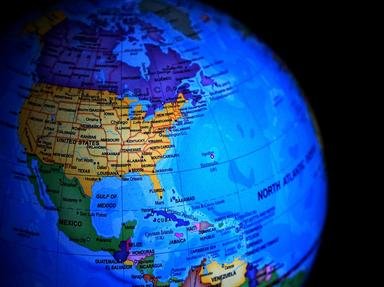Quiz Answer Key and Fun Facts
1. As our Whirlwind Tours yacht approaches Bermuda from the northwest, check out the view through the glass-bottomed hull. We'll be passing over several of the country's 300-odd shipwrecks, so try not to think about the fact that we're in a ship ourselves! The ships would run aground on a natural feature that extends up to ten miles from the Bermudian shore. What feature is this?
2. We're much closer to Bermuda now, and you can see that the land in its southwest has a sort of crescent shape. Narrow islands curve around a deep sound of clear blue water; the whole length of the six main islands is only about 35.4 kilometers or 22 miles. Bermuda's shape is closely tied to its beginning. Which of these events is responsible for the way the islands look today?
3. Please sit tight as we tie up our yacht at the Dockyard, on Bermuda's northwest tip. There we go! You'll have some time to explore the Dockyard on your own: you can watch the glassblowers, swim with dolphins, have a drink at the Frog and Onion or even go jetskiing. Just be careful when you cross the street: traffic moves on the left. It's yet another legacy of what colonial power, which built the Dockyard as a naval base?
4. If you're all settled in on the bus, we'll start the overland component of our tour. There's some beautiful scenery just outside those windows: colorful flowers, a glittering ocean, pastel houses ... Now take a closer look at those houses. Bermudian rooftops are very distinctive with their bright white paint and shallow terraces. Their design is dictated by the geography here. What problem do the roofs help solve?
5. Enough driving for now -- I've seen your soulful looks at the water outside the bus windows! We'll stop here at Horseshoe Beach, famous for its crescent shape, clear water, picturesque rocks and pink sand. Where does that celebrated color come from?
6. Have you all enjoyed your beach visit? We're going to take another bus trip now: it's about a twenty-minute ride to Bermuda's capital city. This is where the public buses and ferries fan out to the rest of the island, if you'd like to come back and explore on your own. You'll also find shopping, museums and some lovely colonial architecture. What's the name of this city?
7. If you've all found the perfect souvenir, we can take a walk down Front Street to see the parade! We have a fine opportunity to see some unique Bermudian dancers who traditionally performed only around Christmas and Easter. Their colorful regalia is inspired by tropical birds, and their name comes from a West African word for "drum" or "rhythm." Who are they?
8. There's more than one reason that Bermuda became a smuggler's paradise, and limestone is one of them. Soft rock and abundant water combine to make impressive networks of caves! As we head northeast, we'll visit Bermuda's most famous cave, discovered in 1905 and named for its clear waters. Where are we going?
9. We'll continue on the bus to the Town of St. George, a World Heritage site at the northeast tip of Bermuda. There's a replica of a sailing ship from 1610 in the harbor, near the stocks and ducking stool where you can see reenactments of 18th-century justice. Just two blocks away is the Western Hemisphere's oldest continuously used Anglican church, where generations of Bermudians have sought the keys to the kingdom. What is the church's name?
10. I'm afraid this is the end of our tour, but we do have one more Bermuda treat for you. Take a seat here, overlooking St. George's Harbour, and enjoy one of the two national drinks: the Dark 'n' Stormy and the Swizzle. They both have the same active ingredient, an alcohol fermented from Bermuda's main historical crop. What is this type of alcohol?
Source: Author
CellarDoor
This quiz was reviewed by FunTrivia editor
Pagiedamon before going online.
Any errors found in FunTrivia content are routinely corrected through our feedback system.

